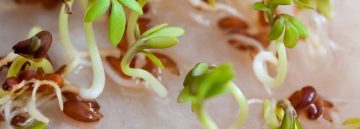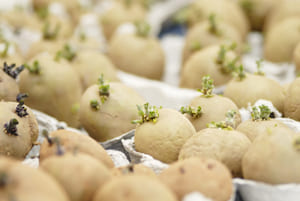
Quite a few people have asked about pre-sowing treatments, so below is a quick run-down of key points.
Seeds may be treated in a number of ways before sowing. These techniques are known as pre-sowing treatments. They can improve:
- germination rate
- speed of germination
- health of seeds and adult plants
- ease of sowing.
Chitted (Pre-Germinated) Seeds
This approach is used for many popular plants that are difficult to germinate unless you are able to maintain a suitable temperature. Cucumbers are often sold in this way. The seeds are usually pre-germinated on trays of nutrient gel, supplying all the moisture and nutrients required. They will usually be delivered in a sealed plastic container, still on the gel. Such seeds need to be delivered promptly and planted immediately on arrival as the root will already have emerged from the seed. The supplier usually provides specific growing instructions depending on the seeds ordered.

Perhaps the most well-known example of chitting comes from potatoes. It is common to encourage seed potatoes to sprout before planting.
- Growers can begin chitting potatoes from late January in warmer parts of the country or February in cooler areas. Chitting should begin about six weeks before planting out.
- If you study a seed potato you will see that it is more rounded and blunt at one end, where there are also a number of ‘eyes’.
- Stand the seed potatoes with their blunt end uppermost in trays or old egg boxes, with plenty of natural light.
- The potatoes are ready to plant out once the shoots are 1.5-2.5cm (0.5-1in) long.
Primed Seeds
These are seeds that have been stored and treated to bring them to the point where they are ready to germinate. Any inbuilt dormancy will have been broken, so you should have seeds that germinate faster and more evenly than non-primed seed. However, research has shown that non-primed seed quickly catches up – an interesting point as primed seeds are generally much more expensive than untreated seeds.
Coated or Pelleted Seeds
These seeds are coated with a material that makes them larger, so they are easier to handle and to space out evenly when sowing them. (Another way of addressing this problem is to mix them thoroughly with fine silver sand.) Sometimes the coating also contains a fungicide or nutrients. It is essential to keep the compost around pelleted seeds moist in order for them to germinate successfully.
Tapes and Gels
It is also possible to buy soluble tapes which have precisely spaced seeds embedded in an organic, water-soluble material. When planted, the tape dissolves and the seeds germinate normally. Seed tapes are especially convenient for tiny, hard-to-handle seeds. However, tapes are much more expensive per seed. Seed tapes allow uniform emergence of seedlings, eliminate overcrowding and permit sowing in perfectly straight rows. The tapes can be cut at any point for multiple row plantings, and thinning is rarely necessary.
Organic gels contain an even distribution of seeds, and are quite paste like. They can be squeezed into the drills. (This is sometimes known as fluid sowing.)
